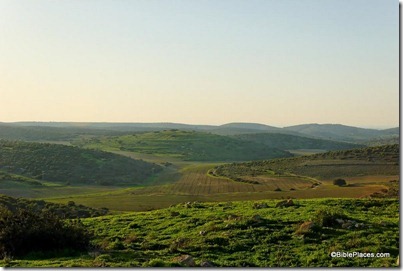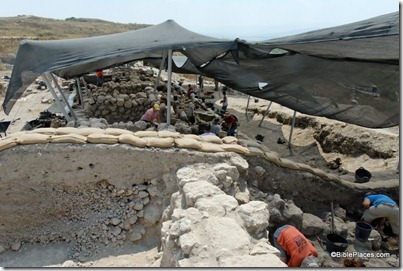Caiaphas was the high priest in Jerusalem in the early part of the first century, and he is best known for his role in the trial of Jesus (Matt 26:57-68). This ossuary belonged to his granddaughter and was looted from a tomb in the Elah Valley. The correspondence with New Testament names is interesting. Caiaphas’ son was named Jesus (Yeshua) and his granddaughter Mary (Miriam).
From the Israel Antiquities Authority press release:
Three years ago the Israel Antiquities Authority Unit for the Prevention of Antiquities Robbery acquired a decorated ossuary bearing an engraved inscription. The ossuary was discovered by antiquities robbers who plundered an ancient Jewish tomb of the Second Temple period. During the course of the investigation it was determined that the ossuary came from a burial cave in the area of the Valley of ’Elah, in the Judean Shephelah.
To check the authenticity of the artifact and the significance of the engraved inscription, the Israel Antiquities Authority turned to Dr. Boaz Zissu of the Department of the Land of Israel Studies and Archaeology of Bar Ilan University and Professor Yuval Goren of the Department of Archaeology and Ancient Near Eastern Civilizations of the Tel Aviv University.
This week, the two scientists published the results of their research, which summarize the importance of the find and confirm its genuineness. The study appears in the Israel Exploration Journal (Volume 61) published this week by the Israel Exploration Society.
Ossuaries are small stone chests that Jews used for secondary burial of bones; they were quite common in tombs in Israel from the late first century BCE until the beginning of the second century CE. The front of the ossuary that was found is decorated with a stylized floral motif above which is a long Aramaic inscription engraved in Jewish script:
‘Miriam Daughter of Yeshua Son of Caiaphas, Priests [of] Ma’aziah from Beth ’Imri’
(or, an alternative reading:
‘Miriam Daughter of Yeshua Son of Caiaphas, Priest of Ma’aziah from Beth ’Imri’)
In the conclusion of their study Dr. Boaz Zissu and Professor Yuval Goren write, “the prime importance of the inscription lies in the reference to the ancestry of the deceased – Miriam daughter of Yeshua – to the Caiaphas family, indicating the connection to the family of the Ma’aziah course of priests of Beth ’Imri”. Caiaphas is the name of Yeshua’s father, and Miriam’s grandfather. From the wording of the inscription we learn that he belonged to a famous family of priests that was active in the first century CE. One family member, the high priest Yehosef Bar Caiaphas, is especially famous for his involvement in the trial and crucifixion of Jesus.
Ma’aziah /Ma’aziahu is the last of the twenty four priestly courses that served in the Temple in Jerusalem. The list of courses, which was formulated during King David’s reign, appears in the Bible in I Chronicles (I Chronicles 24:18). The signatories to the pledge in the days of Nehemiah include among others, “Maʽaziah, Bilgai, Shem’aiah; these are the priests” (Nehemiah 10: 9). This is the first reference to the Maʽaziah course in an epigraphic find from the Second Temple period. For the first time we learn from an inscription that the Caiaphas family was related to the Ma’aziah course.
[…]
Since the ossuary in question was not found in a controlled archaeological excavation and because of its special scientific importance, it was subjected to microscopic examinations using an environmental scanning electron microscope/energy dispersive spectrometer (ESEM/EDS), the purpose of which was to evaluate its authenticity. The patina covering the sides was checked, with emphasis on the patina covering the inscription. The examinations determined that the inscription is genuine and ancient.
The Israel Antiquities Authority is distressed by the fact that this important find, which was plundered from its original provenance, was removed from its archeological context, thus it will never be possible to know the full story of the burial cave. Sadly, the robbers’ desire of monetary gain has erased entire pages of the country’s cultural history.
The press release is now online. A small photograph is posted here, and Arutz-7 also has the story in English. The AP has a brief article.
For more details, see the article by Zissu and Goren in the current issue of Israel Exploration Journal.
For information about the ossuary of Caiaphas excavated in Jerusalem in 1990, see this post in the series of “Top Ten Biblical Discoveries in Archaeology.”
UPDATE: Ferrell Jenkins has a link to a larger photo.
UPDATE #2: Jim West has a very high-resolution photo from the archaeologist along with three
other AP images. In the comments on that post, Jack Kilmon suggests that this ossuary belonged to the niece, not the granddaughter, of the NT figure. The Jerusalem Post now has an article based on the press release.
HT: Joseph Lauer

